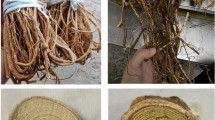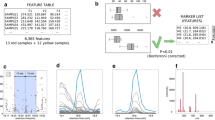Abstract
Crataegus products for food, nutritional, and pharmaceutical uses are available over the counter in the global market. The aerial parts are enriched with biochemicals and are used to treat cardiovascular, respiratory, and liver disorders and cancer. Detailed study to understand the chemical composition and different levels within medicinally important plant tissues needs hours, such as plant response for metabolite flux and quality control purposes. Therefore, comprehensive metabolite profiling (qualitatively and quantitatively) of different tissues [leaves, flowers, stems, fruits (without seeds), and seeds; n = 5] of Crataegus rhipidophylla Gand. was performed by NMR techniques in one session. Fifty-eight compounds of different classes were unambiguously identified with the use of 1D and 2D NMR techniques (1H, 13C, distortionless enhancement by polarization transfer with 135° angle, correlation spectroscopy, heteronuclear single quantum coherence, heteronuclear multiple bond correlation) and quantified by a relative quantification method. Chemical compounds such as amygdalin (seeds), rutin (flowers), isovitexin (fruits), shikimic acid (leaves), and epicatechin (stems) were identified as authentication as well as discrimination markers for the respective C. rhipidophylla tissues. The fruits contain a significant mixture of important metabolites, followed by flowers and leaves. Trends of metabolite levels, upregulation, and downregulation in plant tissues were found, which highlights the responses of plant tissues in a specific time. NMR-based comprehensive metabolite information was used to develop the chemical signature, quality control chemical markers, and strategies to understand the chemical diversity of C. rhipidophylla. This chemical information from different aerial tissues will provide guidance for the extensive utilization of Crataegus.




Similar content being viewed by others
References
Hubert J, Nuzillard JM, Purson S, Hamzaoui M, Borie N, Reynaud R, et al. Identification of natural metabolites in mixture: a pattern recognition strategy based on 13C NMR. Anal Chem. 2014;86:2955–62.
Dunn WB, Ellis DI. Metabolomics: current analytical platforms and methodologies. Trends Anal Chem. 2005;24:285–94.
Hur M, Campbell AA, Almeida-de-Macedo M, Li L, Ransom N, Jose A, et al. A global approach to analysis and interpretation of metabolic data for plant natural product discovery. Nat Prod Rep. 2013;30:565–83.
Wishart DS. Quantitative metabolomics using NMR. Trends Anal Chem. 2008;27:228–37.
Ward JL, Baker JM, Beale MH. Recent applications of NMR spectroscopy in plant metabolomics. FEBS J. 2007;274:1126–31.
Kashyap CP, Arya V, Thakur N. Ethnomedicinal and phytopharmacological potential of Crataegus oxyacantha Linn. - a review. Asian Pac J Trop Biomed. 2012:1194–9.
Kumar D, Arya V, Bhat ZA, Khan NA, Prasad DN. The genus Crataegus: chemical and pharmacological perspectives. Rev Bras. 2012;22(5):1187–200.
Ju LY. Crataegus oxyacantha (aubepine) in the use as herb medicine in France. Zhongguo Zhong Yao Za Zhi. 2005;30:634–40.
Chang Q, Zuo Z, Harrison F, Chow MS. Hawthorn. J Clin Pharmacol. 2002;42:605–12.
Kumar D, Kumar P, Sharma U. UPLC-DAD-MS based quality control and discrimination analysis of different aerial parts of Crataegus rhipidophylla Gand. found in Indian Western Himalaya. Anal Chem Lett. 2018;8(2):177–87.
Kim HK, Choi YH, Verpoorte R. NMR-based metabolomic analysis of plants. Nat Protoc. 2010;5:536–49.
Kumar D, Kumar R, Sing B, Ahuja PS. Comprehensive metabolomic profiling of an ndangered medicinal plant Picrorhiza kurroa Royle ex Benth cultivated in Indian Himalayas. Comb Chem High Throughput Screen. 2016;19:200–15.
Kumar D, Gulati A, Sharma U. Determination of theanine and catechin in Camellia sinensis (Kangra tea) leaves by HPTLC and NMR techniques. Food Anal Methods. 2016;9:1666–74.
Ailiesei GL, Ciobanu M, Balan M, Stavarache C, Barbes L, Nicolescu A, et al. NMR detected metabolites in complex natural fluids. Quinic acid in apple juice. Ovidius Univ Ann Chem. 2015;6(2):51–6.
Porzel A, Farag MA, Mülbradt J, Wessjohann LA. Metabolite profiling and fingerprinting of Hypericum species: a comparison of MS and NMR metabolomics. Metabolomics. 2014;10(4):574–88.
De BA, Van LJ. The identification by 1H- and 13C-NMR spectroscopy of sucrose, 1-kestose, and neokestose in mixtures present in plant extracts. Carbohydr Res. 1991;211:131–6.
Kutyshenko VP, Arkadij YU, Budantsev I, Uversky VN. Analysis of seasonal changes in plants by high-resolution NMR spectroscopy: looking at the aqueous extracts from different plant tissues. J Nat Sci. 2015;1(5):88–95.
Payn R, Edmonds M. Isolation of shikimic acid from star aniseed. J Chem Educ. 2005;82(4):599–600.
Masuda T, Odaka Y, Ogawa N, Nakamoto K, Kuninaga H. Identification of geranic acid, a tyrosinase inhibitor in lemongrass (Cymbopogon citratus). J Agric Food Chem. 2007;56(2):597–601.
Liu M, Yang S, Jin L, Hu D, Wu Z, Yang S. Chemical constituents of the ethyl acetate extract of Belamcanda chinensis (L.) DC roots and their antitumor activities. Molecules. 2012;17:6156–69.
Gogna N, Hamid N, Dorai K. Metabolomic profiling of the phytomedicinal constituents of Carica papaya L. leaves and seeds by 1H NMR spectroscopy and multivariate statistical analysis. J Pharm Biomed Anal. 2015;115:74–85.
Dewick PM. Medicinal natural products: a biosynthetic approach. Chichester: Wiley; 2009.
Hicks JM, Muhammad A, Ferrier J, Saleem A, Cuerrier A, Arnason JT, et al. Quantification of chlorogenic acid and hyperoside directly from crude blueberry (Vaccinium angustifolium) leaf extract by NMR spectroscopy analysis: single-laboratory validation. J AOAC Int. 2012;95(5):1406–11.
Hossain MA, Ismail Z. Isolation and characterization of triterpenes from the leaves of Orthosiphon stamineus. Arab J Chem. 2013;6(3):295–8.
Rashed KN, Butnariu M. Isolation and antimicrobial and antioxidant evaluation of bio-active compounds from Eriobotrya japonica stems. Adv Pharm Bull. 2014;4(1):75–81.
Ahn KS, Hahm MS, Park EJ, Lee HK, Kim IH. Corosolic acid isolated from the fruit of Crataegus pinnatifida var. psilosa is a protein kinase C inhibitor as well as a cytotoxic agent. Planta Med. 1998;64:468–70.
Park SW, Yook CS, Lee HK. Chemical components from the fruits of Crataegus pinnatifida var. psilosa. Korean J Pharmacogn. 1994;25:328–35.
Khoo LW, Mediani A, Zolkeflee NKZ, Leong SW, Ismail IS, Khatib A. Phytochemical diversity of Clinacanthus nutans extracts and their bioactivity correlations elucidated by NMR based metabolomics. Phytochem Lett. 2015;14:123–33.
Farag MA, Otify A, Porzel A, Michel CG, Elsayed A, Wessjohann LA. Comparative metabolite profiling and fingerprinting of genus Passiflora leaves using a multiplex approach of UPLC-MS and NMR analyzed by chemometric tools. Anal Bioanal Chem. 2016;408(12):3125–43.
Leiss KA, Cristofori G, Steenis R, Verpoorte R, Klinkhamer PG. An eco-metabolomic study of host plant resistance to western flower thrips in cultivated, biofortified and wild carrots. Phytochemistry. 2013;93:63–70.
Scognamiglio M, DAbrosca B, Esposito A, Fiorentino A. Chemical composition and seasonality of aromatic Mediterranean plant species by NMR-based metabolomics. J Anal Methods Chem. 2015;2015:258570.
Koeppen BH, Roux DG. Aspalathin: a novel C-glycosyl flavonoid from Aspalathus linearis. Tetrahedron Lett. 1965;39:3497–503.
Marchev A, Yordanova Z, Alipieva K, Zahmanov G, Rusinova VS, Kapchina TV, et al. Genetic transformation of rare Verbascum eriophorum Godr. plants and metabolic alterations revealed by NMR-based metabolomics. Biotechnol Lett. 2016;38(9):1621–9.
Tanaka S, Fujita Y, Parry HE, Yoshizawa AC, Morimoto K, Murase M. Mass: a visualization and analysis tool for mass spectrometry. J Proteome Res. 2014;13:3846–53.
Teo CC, Tan SN, Yong JW, Ong LL. Determination of metabolites from Scutellaria baicalensis by GC/MS and 1H NMR. Anal Lett. 2013;46(12):1937–50.
Wu X, Ning L, Lia AH, Tang H. An optimized method for NMR-based plant seed metabolomic analysis with maximized polar metabolite extraction efficiency, signal-to-noise ratio, and chemical shift consistency. Analyst. 2014;139:1769–78.
Reid RS. The proton NMR spectrum of ascorbic acid; a relevant example of deceptively simple second-order behavior. J Chem Educ. 1989;66(4):344–5.
Leiss KA, Maltese F, Choi YH, Verpoorte R, Klinkhamer PGL. Identification of chlorogenic acid as a resistance factor for thrips in Chrysanthemum. Plant Physiol. 2009;150(3):1567–75.
Sobolev AP, Brosio E, Gianferri R, Segre AL. Metabolic profile of lettuce leaves by high field NMR spectra. Magn Reson Chem. 2005;43(8):625–38.
Wang M, Etu J, Joshi S. Enhanced disruption of the blood brain barrier by intracarotid mannitol injection during transient cerebral hypoperfusion in rabbits. J Neurosurg Anesthesiol. 2007;19:249–56.
Bochkov DV, Sysolyatin SV, Kalashnikov AI, Surmacheva IA. Shikimic acid: review of its analytical, isolation, and purification techniques from plant and microbial sources. J Chem Biol. 2012;5(1):5–17.
Usuki T, Yasuda N, Yoshizawa-Fujita M, Rikukawa M. Extraction and isolation of shikimic acid from Ginkgo biloba leaves utilizing an ionic liquid that dissolves cellulose. Chem Commun. 2011;47:10560–2.
Crombie L, King RW, Whiting DA. Carbon-13-magnetic resonance spectra. Synthetic presqualene esters, related cyclopropanes and isoprenoids. J Chem Soc Perkin Trans. 1975;1:913–5.
Robbins RJ. Phenolic acids in foods: an overview of analytical methodology. J Agric Food Chem. 2003;51(10):2866–87.
Owen RW, Haubner R, Mier W, Giacosa A, Hull WE, Spiegelhalder B, et al. Isolation, structure elucidation and antioxidant potential of the major phenolic and flavonoid compounds in brined olive drupes. Food Chem Toxicol. 2003;41:703–17.
Svehlikova V, Bennett RN, Mellon FA, Needs PW, Piacente S, Kroon PA, et al. Isolation, identification and stability of acylated derivatives of apigenin 7-O-glucoside from chamomile (Chamomilla recutita [L.] Rauschert). Phytochemistry. 2004;65:2323–32.
Acknowledgements
The authors kindly acknowledge The Director, Council of Scientific and Industrial Research (CSIR) Institute of Himalayan Bioresource Technology (IHBT), Palampur, for support and infrastructure. The authors also acknowledge Dharam Singh for the collection of plant material from Pangi region of Himachal Pradesh, India, and Brij Lal for authentication of plant species. This activity was supported by the Science and Engineering Research Board, Department of Science and Technology, New Delhi, under the Fast Track Scheme for Young Scientists (SB/YS/LS-81/2014) and the CSIR (MLP 0203). The CSIR IHBT publication number for this article is 4172.
Author information
Authors and Affiliations
Corresponding author
Ethics declarations
Conflict of interest
The authors declare that they have no competing interests.
Additional information
Publisher’s note
Springer Nature remains neutral with regard to jurisdictional claims in published maps and institutional affiliations.
Electronic supplementary material
ESM 1
(PDF 1427 kb)
Rights and permissions
About this article
Cite this article
Kumar, D., Thakur, K., Sharma, S. et al. NMR for metabolomics studies of Crataegus rhipidophylla Gand.. Anal Bioanal Chem 411, 2149–2159 (2019). https://doi.org/10.1007/s00216-019-01646-z
Received:
Revised:
Accepted:
Published:
Issue Date:
DOI: https://doi.org/10.1007/s00216-019-01646-z




